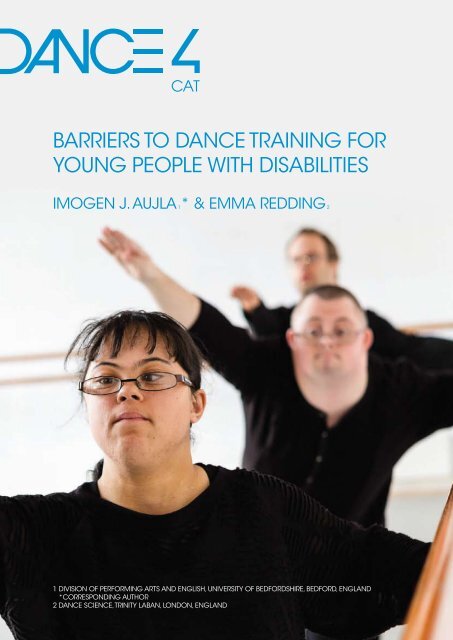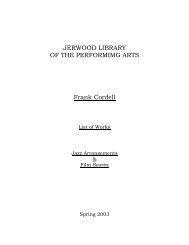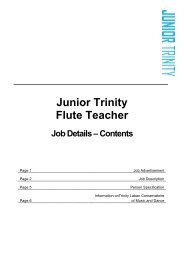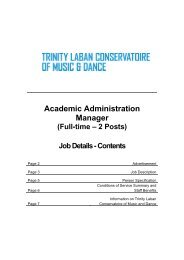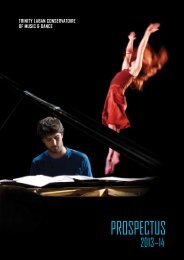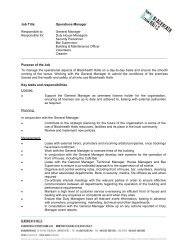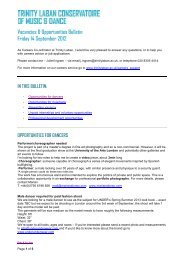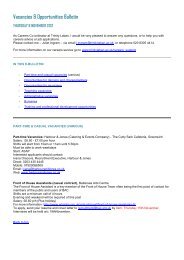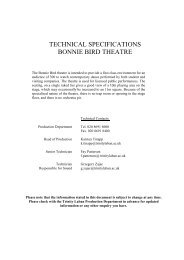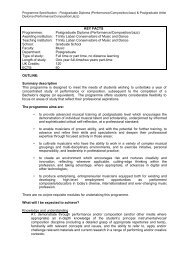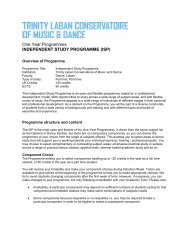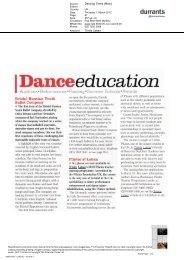barriers to dance training for young people with disabilities - Dance4
barriers to dance training for young people with disabilities - Dance4
barriers to dance training for young people with disabilities - Dance4
Create successful ePaper yourself
Turn your PDF publications into a flip-book with our unique Google optimized e-Paper software.
Barriers <strong>to</strong> <strong>dance</strong> <strong>training</strong> <strong>for</strong><strong>young</strong> <strong>people</strong> <strong>with</strong> <strong>disabilities</strong>Imogen J. Aujla 1* & Emma Redding 21 Division of Per<strong>for</strong>ming Arts and English, University of Bed<strong>for</strong>dshire, Bed<strong>for</strong>d, England*Corresponding author2 Dance Science, Trinity Laban, London, England
Barriers <strong>to</strong> <strong>dance</strong> <strong>training</strong> <strong>for</strong><strong>young</strong> <strong>people</strong> <strong>with</strong> <strong>disabilities</strong>Imogen J. Aujla 1* & Emma Redding 2Dance is a viable and enjoyable activity – and potential career – <strong>for</strong> <strong>young</strong> <strong>people</strong> <strong>with</strong><strong>disabilities</strong>, yet they face several <strong>barriers</strong> <strong>to</strong> participation and <strong>training</strong>. The aim of this paperis <strong>to</strong> review the literature around <strong>barriers</strong> <strong>to</strong> <strong>dance</strong> <strong>training</strong> <strong>for</strong> <strong>young</strong> disabled <strong>people</strong> and <strong>to</strong>put <strong>for</strong>ward practical recommendations <strong>for</strong> overcoming these challenges. The main <strong>barriers</strong>identified were aesthetic, attitudinal, <strong>training</strong>-related and logistical in nature, <strong>with</strong> further <strong>barriers</strong>related <strong>to</strong> physical access and a lack of knowledge or available in<strong>for</strong>mation about opportunities.One of the key recommendations <strong>for</strong> overcoming these <strong>barriers</strong> is <strong>to</strong> build an effective networkbetween special and mainstream schools, <strong>dance</strong> studios, youth <strong>dance</strong> groups and professionalintegrated <strong>dance</strong> companies in order <strong>to</strong> encourage <strong>dance</strong> participation at a range of levels andsupport <strong>young</strong> disabled <strong>people</strong> throughout their <strong>dance</strong> journeys.1 Division of Per<strong>for</strong>ming Arts and English, University of Bed<strong>for</strong>dshire, Bed<strong>for</strong>d, England*Corresponding author2 Dance Science, Trinity Laban, London, England 2
IntroductionDance can be an inspiring, challenging and rewarding activity, yet there are several <strong>barriers</strong><strong>to</strong> participation <strong>for</strong> <strong>young</strong> <strong>people</strong> <strong>with</strong> <strong>disabilities</strong>. Dance is a physical and artistic disciplineand there<strong>for</strong>e may not au<strong>to</strong>matically be considered as a suitable activity <strong>for</strong> <strong>young</strong> disabled<strong>people</strong>; nevertheless there are numerous examples of successful professional disabled <strong>dance</strong>rswho are challenging these perceptions <strong>with</strong>in the <strong>dance</strong> sec<strong>to</strong>r in innovative ways (e.g. ClaireCunningham, Mark Brew, Caroline Bowditch and Chris Pavia). Many per<strong>for</strong>ming artists <strong>with</strong><strong>disabilities</strong> take idiosyncratic routes in<strong>to</strong> the profession; most commonly, <strong>training</strong> happens ‘onthe job’ <strong>with</strong>in a disability-specific company rather than via mainstream <strong>training</strong> routes (Verrent,2003). Indeed, most <strong>dance</strong> provision <strong>for</strong> <strong>young</strong> disabled <strong>people</strong> is recreational in nature, focusingon creativity and fun rather than specific technical development. As such there is a clear gap inprovision between recreational participation and the profession. This suggests either that <strong>young</strong>disabled <strong>people</strong> are not accessing <strong>dance</strong> <strong>training</strong>, or they are excluded from participating.In order <strong>to</strong> increase participation and access <strong>to</strong> <strong>training</strong>, and <strong>to</strong> promote <strong>dance</strong> as a viableactivity <strong>for</strong> <strong>young</strong> disabled <strong>people</strong>, it is important <strong>to</strong> understand the <strong>barriers</strong> that individuals facein their pursuit of <strong>dance</strong>. The aim of this paper is <strong>to</strong> review the literature regarding <strong>barriers</strong> <strong>to</strong><strong>dance</strong> <strong>training</strong> <strong>for</strong> <strong>young</strong> <strong>people</strong> <strong>with</strong> <strong>disabilities</strong>, and <strong>to</strong> recommend practical ways in whichthese <strong>barriers</strong> might be overcome. Given the relatively limited amount of academic researchconducted <strong>with</strong>in this area, the literature search not only included academic journal articlesand academic books but also books and guides <strong>for</strong> <strong>dance</strong> practitioners, evaluation reports, ArtsCouncil reports and magazine articles. Each barrier identified below is discussed in relation <strong>to</strong>recommendations from the literature, discussions <strong>with</strong> experts in the field and the researchers’own knowledge and experience.3
AttitudinalAttitudinal <strong>barriers</strong> can come from disabled <strong>young</strong> <strong>dance</strong>rs themselves, from peers, parentsand carers, teachers, companies, audiences, and critics. The per<strong>for</strong>ming arts are not typicallyperceived as a viable, or appropriate, activity (never mind career) <strong>for</strong> <strong>people</strong> <strong>with</strong> <strong>disabilities</strong>(Delin, 2002). Discouragement may come from parents or carers who lack knowledge andunderstanding of the thriving disability arts scene, and may wish <strong>to</strong> protect their children frompotential disappointment (Delin, 2002; Whatley, 2008). Well-intentioned discouragement mayalso occur in school environments; <strong>for</strong> example in special schools, arts classes tend <strong>to</strong> focusmore on therapy than achievement (Walker, 2006). While there is value in the therapeutic use ofthe arts, it suggests that <strong>people</strong> <strong>with</strong> <strong>disabilities</strong> are somehow incapable of creating art worthyof being seen by others (Barnes, 2003). In mainstream schools, there may be a perception that<strong>dance</strong> is irrelevant <strong>to</strong> students <strong>with</strong> <strong>disabilities</strong>, and opportunities <strong>to</strong> participate are often limited(Verrent, 2007). Meanwhile, non-disabled children often assume that disabled children cannot<strong>dance</strong> (Zi<strong>to</strong>mer & Reid, 2011). Even when a <strong>young</strong> disabled person accesses <strong>dance</strong>, teacherexpectations of potential <strong>for</strong> achievement tend <strong>to</strong> be lower than their expectations of students<strong>with</strong>out <strong>disabilities</strong> (deRight, 2009). Finally, in terms of higher-level <strong>training</strong>, some vocational <strong>dance</strong>schools perceive that elite <strong>training</strong> is in opposition <strong>to</strong> accessible <strong>training</strong> (Neelands, Lindsay,Freakley, Band, Galloway, Lindley & Roberts, 2006; Verrent, 2003). As such, even if parents and/orschool staff are supportive of a <strong>young</strong> person’s <strong>dance</strong> involvement, he or she may be excludedfrom participating in opportunities that are more than recreational.More work clearly needs <strong>to</strong> be done <strong>to</strong> change <strong>people</strong>’s attitudes <strong>to</strong>wards <strong>dance</strong> as a viableactivity <strong>for</strong> <strong>young</strong> <strong>people</strong> <strong>with</strong> <strong>disabilities</strong>. The visibility of disabled <strong>people</strong> in the arts must beincreased, while <strong>dance</strong> providers should offer both disability awareness <strong>training</strong> and specificteacher <strong>training</strong> in integrated practice <strong>for</strong> their staff. Non-disabled students may also benefit fromdisability awareness <strong>training</strong> (Whatley, 2007; Verrent, 2003) in order <strong>to</strong> participate more confidentlyin integrated classes, and <strong>to</strong> ensure that the future generation of <strong>dance</strong> artists are aware ofinclusion and access issues. Finally, providers may consider giving advice <strong>to</strong> parents about thenature of <strong>dance</strong> <strong>training</strong> and potential <strong>dance</strong> careers (Whatley, 2008). Given the level of familysupport essential in talent development in general (Walker, Nordin-Bates & Redding, 2010), andsuggestions that <strong>young</strong> <strong>people</strong> <strong>with</strong> <strong>disabilities</strong> may need extra encouragement and support inorder <strong>to</strong> follow their dreams (Fitzgerald & Kay, 2005; Martin & Wheeler, 2011), engaging parents inthe <strong>training</strong> process will increase their understanding of disability <strong>dance</strong>.4
TRAININGIf a <strong>young</strong> disabled person decides <strong>to</strong> pursue <strong>dance</strong> <strong>training</strong>, three key problems can emerge:the lack of available technical <strong>training</strong>, the content of <strong>dance</strong> <strong>training</strong> sessions (in particular themovement material used), and teachers’ lack of knowledge in how best <strong>to</strong> train <strong>young</strong> <strong>people</strong><strong>with</strong> <strong>disabilities</strong>. Perhaps the largest barrier is the notable lack of regular classes focused onprogression, accredited courses, and vocational <strong>training</strong> available <strong>to</strong> <strong>dance</strong>rs <strong>with</strong> <strong>disabilities</strong>(Charnley, 2011; Verrent, 2003). While there are a large number of first access participa<strong>to</strong>ryopportunities, most of these are recreational or therapeutic in nature, emphasising creativity andfun. Although such experiences can be invaluable, many <strong>young</strong> disabled <strong>dance</strong>rs may wish<strong>to</strong> improve their technical competence but find few opportunities in which <strong>to</strong> do so; <strong>dance</strong>rs<strong>with</strong> <strong>disabilities</strong> have reported that technical skill-building did not <strong>for</strong>m a substantial part of their<strong>training</strong> (Verrent, 2003). Instead, ad hoc and idiosyncratic routes in<strong>to</strong> the <strong>dance</strong> profession arecurrently the norm; a framework <strong>for</strong> talent development does not exist <strong>for</strong> <strong>training</strong> disabled<strong>dance</strong>rs.Building progression routes will undoubtedly take time. Early provision is necessary so that <strong>young</strong>children become familiar <strong>with</strong> <strong>dance</strong> from a <strong>young</strong> age and subsequently find it easier <strong>to</strong>access mainstream options (Schwyzer, 2005). This may begin <strong>with</strong> opportunities after school thatintroduce <strong>young</strong> disabled <strong>people</strong> <strong>to</strong> <strong>dance</strong> and signpost them <strong>to</strong> other opportunities <strong>with</strong>in thelocal area. Organisations and companies could offer summer schools or intensive weekendsin order <strong>to</strong> gauge the level of interest and <strong>to</strong> ‘get the word out’ (Verrent, 2007). Vocationalschools and universities could deliver targeted outreach <strong>to</strong> attract potential students on<strong>to</strong> theirprogrammes (Verrent, 2003). One other example is <strong>to</strong> encourage <strong>young</strong> disabled <strong>people</strong> <strong>to</strong>access <strong>dance</strong> via private studios. The first experience of <strong>dance</strong> <strong>for</strong> many <strong>young</strong> <strong>people</strong> is throughprivate studios, taking exams in styles such as ballet and tap <strong>with</strong> established exam boards.Importantly, two of the main exam boards, the Royal Academy of Dance (RAD) and the ImperialSociety of Teachers of Dancing, enable <strong>young</strong> <strong>dance</strong>rs <strong>with</strong> <strong>disabilities</strong> <strong>to</strong> apply <strong>for</strong> exams <strong>with</strong>reasonable adjustments such as allowing more time or rest breaks <strong>for</strong> disabled candidates.According <strong>to</strong> the RAD, the number of applications <strong>for</strong> reasonable adjustments is steadilyincreasing over time, as can be seen in Table 1, although the <strong>to</strong>tal number of students applying<strong>for</strong> reasonable adjustments is still relatively very small.5
Table 1. Reasonable adjustment applications versus <strong>to</strong>tal exam entry figures (RAD)YEARREASONABLEADJUSTMENTTOTAL EXAMENTRIESPERCENTAGE2007-082008-092009-102010-1117819924228565,23963,10659,37459,0730.270.320.410.48The content of <strong>dance</strong> sessions is a second <strong>training</strong>-related barrier. Talent development typicallyentails working on the technical and artistic aspects of <strong>dance</strong> by learning codified ‘set’techniques. These codified techniques tend <strong>to</strong> be based on a certain type of body, meaningthat the movement vocabulary can be a barrier <strong>to</strong> <strong>dance</strong>rs <strong>with</strong> <strong>disabilities</strong>, who are often left<strong>to</strong> adapt material <strong>to</strong> their own bodies (Charnley, 2011; Toole, 2002). It can also be difficult <strong>for</strong>disabled <strong>dance</strong>rs <strong>with</strong>out significant prior <strong>training</strong> <strong>to</strong> understand the structure and discipline ofa technique class, and they may need <strong>to</strong> dedicate more time <strong>to</strong> mo<strong>to</strong>r skill learning (Whatley,2007). Perhaps unsurprisingly, disabled students can lack confidence when participating in <strong>dance</strong>classes, feeling concerned that they will not be able <strong>to</strong> keep up <strong>with</strong> the pace of classes, orthat they will be a burden <strong>to</strong> teachers (Taylor, 2009; Whatley, 2008). For a discussion of specificpractical strategies <strong>for</strong> teaching see Aujla and Redding (2012).Finally, teachers may lack knowledge in how <strong>to</strong> deliver effectively <strong>to</strong> learners <strong>with</strong> diverse needs(Verrent, 2003). For example, <strong>dance</strong>rs <strong>with</strong> physical <strong>disabilities</strong> must plan their time carefully <strong>to</strong>conserve energy and minimise bodily stress, which teachers may not anticipate (Sandahl, 2002).Teachers often lack confidence and report anxiety <strong>with</strong> regard <strong>to</strong> integrated work and adaptingthe curriculum, which can result in them being reticent <strong>to</strong> challenge students <strong>with</strong> <strong>disabilities</strong>(Verrent, 2003; Whatley, 2008). Clearly, teacher <strong>training</strong> is a crucial part of improving access <strong>to</strong><strong>training</strong>, so that teachers are confident in including and challenging <strong>dance</strong>rs <strong>with</strong> <strong>disabilities</strong> inall aspects of a <strong>dance</strong> programme (Schwarz, 2011). Teacher <strong>training</strong> is important <strong>for</strong> practitionersat all levels of provision, including mainstream and special schools, private studios, vocationalschools and universities (Schwarz, 2011; Whatley, 2008; Verrent, 2007). A positive example of howteachers may gain <strong>training</strong> is through the new Master of Teaching (Dance) degree from the RAD,which includes an optional module entitled Inclusive Dance Practice: Disability and SEN. Student<strong>dance</strong>rs can also receive <strong>training</strong> in integrated teaching practice as part of a <strong>dance</strong> degreeprogramme at Winchester, De Mont<strong>for</strong>t and Gloucestershire Universities (Schwarz, 2011).6
QUALIFICATIONSIn relation <strong>to</strong> <strong>training</strong>, it is important <strong>to</strong> consider the role of qualifications because disabledper<strong>for</strong>ming artists have reported a desire <strong>for</strong> both experience and qualifications (Verrent, 2003).Qualifications provide evidence of a <strong>young</strong> <strong>dance</strong>r’s competence in key areas and as suchdemonstrate his or her readiness <strong>to</strong> progress <strong>to</strong> the next level of <strong>training</strong>. After all, no <strong>dance</strong>rcan be judged on a level playing field until it is clear that he or she has achieved a level ofcompetence, and having qualifications is one way of evidencing this. Furthermore, gainingqualifications can impact not only on technical and per<strong>for</strong>mance skills but also on other <strong>dance</strong>skills. For example, knowledge gained from the study of <strong>dance</strong> his<strong>to</strong>ry and analysis will have apositive impact on choreographic exploration as the <strong>dance</strong>r will have an understanding of thework’s creative and his<strong>to</strong>rical context.For schools and community groups, the Arts Council England Arts Awards may be a goodfoundation <strong>for</strong> progression, encouraging students <strong>to</strong> build relationships <strong>with</strong> arts venues andorganisations beyond the school environment (Walker, 2006). Many <strong>dance</strong> groups, such asFRONTLINE and Corali, already offer Arts Awards; some groups, such as Freefall, have writtentheir own qualifications <strong>for</strong> their <strong>dance</strong> <strong>training</strong> and per<strong>for</strong>mance activities. Importantly,accreditation is not only beneficial <strong>for</strong> the individual and his or her progression but may alsohelp the organisation or group <strong>to</strong> survive in a difficult funding climate by demonstrating tangibleoutcomes.7
LOGISTICLogistic <strong>barriers</strong> <strong>to</strong> <strong>dance</strong> <strong>training</strong> include transport, care and support needs; financial costsare often implicated in all of these fac<strong>to</strong>rs (Verrent, 2003, 2007). Dancers <strong>with</strong> <strong>disabilities</strong> tend <strong>to</strong>need a greater length of time <strong>to</strong> train which has obvious financial implications <strong>for</strong> the parents orguardians of the student. Transport issues are also pertinent <strong>to</strong> highlight. While some regions in thecountry are developing progression routes <strong>for</strong> those wishing <strong>to</strong> pursue <strong>dance</strong> as a career, many<strong>young</strong> <strong>people</strong> <strong>with</strong> <strong>disabilities</strong> will be precluded from accessing this provision due <strong>to</strong> the distancesbetween different levels of provision. As an illustration, there are a number of opportunities <strong>for</strong><strong>young</strong> disabled <strong>dance</strong>rs in the North West of England, including recreational classes, youthgroups and continued professional development <strong>for</strong> emerging artists. However, the North West isa geographically large region and accessing these different types of provision may depend uponindividuals’ transport needs.While adult <strong>dance</strong>rs can address these <strong>barriers</strong> via the Access <strong>to</strong> Work organisation – anorganisation which provides practical support <strong>to</strong> help <strong>people</strong> <strong>with</strong> a disability, health or mentalhealth condition get <strong>to</strong> work – no such organisation exists <strong>for</strong> <strong>young</strong> <strong>people</strong>. Personal budgetsand the Disability Living Allowance may go some way in providing assistance <strong>for</strong> <strong>training</strong> andtransport costs, but the current governmental reviews may result in decreased availability and/orflexibility of such funds.8
Building accessDue <strong>to</strong> legislation, most arts venues are now accessible, yet the accessibility of buildings andmaterials can still be an issue <strong>for</strong> <strong>dance</strong>rs <strong>with</strong> <strong>disabilities</strong> (Arts Council England Equality ImpactAssessment Investment Strategy 2012-2015). Sandahl (2002) highlights how theatrical spacesdictate who can participate and at what level. For instance, many theatres are now accessible<strong>for</strong> audiences, but the stage itself and backstage areas such as dressing rooms remaininaccessible. Furthermore, many theatre spaces are only accessible provided no more than threeor four disabled <strong>people</strong> attend at any one time (Scott, 2002). At the school level, Walker (2006)found that mainstream schools tended <strong>to</strong> have better arts facilities than special schools, inhibitingparticipation even at this stage.While Verrent (2003) notes that only 4% of the disabled population use wheelchairs, physicalaccess needs apply not only <strong>to</strong> wheelchair users but also <strong>to</strong> those <strong>with</strong> visual and hiddenimpairments. Pathways and routes around buildings should always be made clear <strong>to</strong> <strong>dance</strong>rs<strong>with</strong> <strong>disabilities</strong>, <strong>for</strong> example the route from the changing room <strong>to</strong> the studio (deRight, 2009).Furthermore, all areas <strong>with</strong>in a venue should be made accessible so that <strong>young</strong> disabled <strong>dance</strong>rsare not only able <strong>to</strong> access the appropriate <strong>training</strong> and per<strong>for</strong>mance environment but can alsoenjoy sociable spaces such as cafés (Jacklin, Robinson, O’Meare & Harris, 2007).9
Lack of knowledgeabout provisionIn<strong>for</strong>mation about available opportunities may be <strong>with</strong>held by well-meaning gatekeepers whojudge <strong>dance</strong> <strong>to</strong> be an inappropriate activity <strong>for</strong> <strong>young</strong> disabled <strong>people</strong> (Delin, 2002). Perhaps in partbecause of this lack of awareness, some organisations have reported low uptake when opportunities<strong>for</strong> <strong>people</strong> <strong>with</strong> <strong>disabilities</strong> were provided (Verrent, 2003). Verrent (2007) also highlighted how a lackof in<strong>for</strong>mation exchange between <strong>dance</strong> organisations offering opportunities in Scotland limitedthe amount of in<strong>for</strong>mation available <strong>to</strong> potential users. In England, there is inconsistent in<strong>for</strong>mationavailable on the websites of the national and regional <strong>dance</strong> agencies (strategic organisationsaimed at developing <strong>dance</strong> activity in specific regions). In<strong>for</strong>mation about <strong>dance</strong> classes, projectsand workshops is presented in very different ways according <strong>to</strong> different <strong>dance</strong> agencies’ websites,meaning that finding relevant in<strong>for</strong>mation is easier in some regions than it is in others. Interestingly,this problem is not restricted <strong>to</strong> <strong>dance</strong>; <strong>for</strong> example, in sport, <strong>young</strong> disabled <strong>people</strong> perceive a lackof available in<strong>for</strong>mation about opportunities available <strong>to</strong> them (Fitzgerald & Kay, 2005). As such,effective dissemination of in<strong>for</strong>mation must be a priority <strong>for</strong> organisations across a range of domains.In<strong>for</strong>mation sharing, mapping of opportunities, email groups, newsletters, and interviews <strong>with</strong> inspiringindividuals may all help <strong>to</strong> increase the amount of available in<strong>for</strong>mation and raise the profile ofdisability <strong>dance</strong> (Delin, 2002; Verrent, 2007). At the very least, the national and regional <strong>dance</strong>agencies should consistently provide up-<strong>to</strong>-date in<strong>for</strong>mation about what is available in their areaand provide links <strong>to</strong> specific <strong>training</strong> opportunities and organisations. The inclusion of thoroughin<strong>for</strong>mation on provision should be part of the <strong>dance</strong> agencies’ remit; <strong>for</strong> example the level andtype of student that classes and courses are suitable <strong>for</strong> should be made clear, <strong>to</strong> enable <strong>young</strong><strong>dance</strong>rs <strong>to</strong> choose between recreational classes and those <strong>with</strong> more specific learning outcomes.Dance agencies, companies and organisations could take greater advantage of social networkingby providing up-<strong>to</strong>-date in<strong>for</strong>mation, including testimonials from participants and links <strong>to</strong> relatedorganisations.10
Dance and Disability NetworkA key recommendation <strong>to</strong> arise from this literature review that may help <strong>to</strong> target all of the above<strong>barriers</strong> is the development of <strong>dance</strong> and disability networks. The development of networksbetween <strong>dance</strong> organisations at various levels appears crucial <strong>to</strong> develop awareness, sharegood practice, provide bridges between <strong>dance</strong> participation, <strong>training</strong> and the profession, andoffer men<strong>to</strong>rship and professional development. There are several ways in which such networkscan be built. Special schools could foster relationships <strong>with</strong> local arts and disability organisations<strong>to</strong> extend opportunities and provide a potential system of progression from school classes <strong>to</strong> thoseorganised by groups <strong>with</strong> specific expertise in the arts (Walker, 2006). Integrated and/or disabilityspecificcompanies and organisations could build links <strong>with</strong> local schools, youth groups andemerging artists <strong>with</strong> <strong>disabilities</strong>. The results of such relationships could include the presentation ofthe work of youth groups as ‘curtain raisers’ prior <strong>to</strong> professional per<strong>for</strong>mances (Schwarz, 2011),and men<strong>to</strong>ring or co-men<strong>to</strong>ring opportunities (Scott, 2005). Companies should also continue<strong>to</strong> build networks <strong>with</strong> vocational schools and universities (Neelands et al., 2006; Verrent, 2003).Establishing such links appears paramount so that those working <strong>with</strong>in integrated companiescan share their understanding of how best <strong>to</strong> train talented <strong>young</strong> <strong>dance</strong>rs <strong>with</strong> <strong>disabilities</strong>.These relationships could involve workshops, teacher <strong>training</strong>, disability awareness <strong>training</strong> <strong>for</strong>non-disabled students, shared showcases, holiday intensives, apprenticeship programmes, andplacements <strong>with</strong> non-disability specific companies.Passionate and dedicated individuals can play an integral part in building networks. For example,in her role as Dance Agent <strong>for</strong> Change at Scottish Dance Theatre, Caroline Bowditch’s workincluded artistic and creative learning, strategic development and research, and disseminationand advocacy. In a relatively short space of time, the impact of this role included over 5,000<strong>people</strong> seeing her choreographic work, over 1,200 <strong>people</strong> attending workshops, over 200 <strong>people</strong>being involved in <strong>training</strong> sessions, and 60 emerging and established artists being involved inmen<strong>to</strong>ring or other professional development activities. One of the strengths of Bowditch’s rolewas the way in which other members of Scottish Dance Theatre were involved and are nowable <strong>to</strong> continue delivering outreach work; something that has been described as a ‘cascading’effect (Verrent, 2010). Bowditch has not only been pivotal in building networks but could also bedescribed as a role model. Indeed, a further benefit of building networks between various levelsof <strong>dance</strong> provision is that it may help <strong>young</strong> <strong>people</strong> <strong>to</strong> identify similarly inspiring role models. Rolemodels can help <strong>young</strong> disabled <strong>dance</strong>rs <strong>to</strong> break down <strong>barriers</strong> and understand how others no<strong>to</strong>nly engage <strong>with</strong> the world around them but also <strong>with</strong> artistic practice, inspiring them <strong>to</strong> continue<strong>with</strong> their own participation (Walker, 2006). There<strong>for</strong>e, the, maintenance and expansion of <strong>dance</strong>and disability networks may have a large impact <strong>for</strong> both individual <strong>dance</strong>rs and the <strong>dance</strong>sec<strong>to</strong>r as a whole.11
CONCLUSIONDance can be a challenging and rewarding activity, and a viable career <strong>for</strong> <strong>people</strong> <strong>with</strong><strong>disabilities</strong>, but <strong>young</strong> disabled <strong>people</strong> wishing <strong>to</strong> access <strong>dance</strong> face several <strong>barriers</strong> includingaesthetic, attitudinal, <strong>training</strong>-related, logistic, and access <strong>barriers</strong>, as well as a lack of knowledgeor available in<strong>for</strong>mation about provision. One of the most effective means of overcoming<strong>barriers</strong> <strong>to</strong> <strong>dance</strong> <strong>training</strong> appears <strong>to</strong> be the establishment of local and national networks in theintegrated <strong>dance</strong> sec<strong>to</strong>r in order <strong>to</strong> build progression routes, increase the visibility of integrated<strong>dance</strong>, signpost <strong>young</strong> <strong>people</strong> <strong>to</strong> activities and provide enrichment opportunities such asshadowing and men<strong>to</strong>ring. The more that communication is facilitated between providers, thegreater the chance that <strong>young</strong> disabled <strong>people</strong> will be encouraged <strong>to</strong> engage in <strong>dance</strong> at arange of levels be it <strong>for</strong> enjoyment or talent development.12
AcknowledgementsThis research was commissioned by <strong>Dance4</strong> <strong>with</strong> funds from the Department <strong>for</strong> Education.ReferencesArts Council England Equality Impact Assessment: Investment Strategy 2012-2015 (n.d.) London:Arts Council England.Arts Council England (2010) Annual Equality Report 2009/2010. London: Arts Council England.Aujla, I. J., & Redding, E. (2012) ‘The identification and development of talented <strong>young</strong> <strong>dance</strong>rs<strong>with</strong> <strong>disabilities</strong>’, Research in Dance Education, 1-17 [online pre-print].Barnes, C. (2003) Effecting change; disability, culture and art? Paper presented at the Finding theSpotlight conference, LIPA.Benjamin, A. (2002) Making an Entrance: Theory and Practice <strong>for</strong> Disabled and Non-DisabledDancers. London: Routledge.Burns, S., & Harrison, S. (2009) Dance mapping: A window on <strong>dance</strong>, 2004-2008. London: ArtsCouncil England.Campbell, F. (2009) ‘Re-constructing the image of the disabled per<strong>for</strong>mer’, Animated.Spring, 26-29.Chan, T. W., Goldthorpe, J., Keaney, E., & Oskala, A. (2008) Dance participationand atten<strong>dance</strong> in England: Findings from the Taking Part survey. London: Arts Council England.Charnley, E. (2011) ‘Towards a new vision of <strong>dance</strong>’, Animated. Winter, 25-27.Cooper Albright, A. (1997) ‘Moving across difference: Dance and disability’, in ChoreographingDifference: The body and identity in contemporary <strong>dance</strong>. Hanover, NH: Wesleyan UniversityPress, 56-92.Delin, A. (2002) Access <strong>to</strong> the arts. Animated. Summer, 13-14.deRight, K. (2009) ‘Evaluation report of DanceXchange’s One Night Only’ [online atwww.<strong>dance</strong>xchange.org.uk/UserFiles/file/Access/One%20Night%20Only%20Evaluation%20Report.pdf]13
Fitzgerald, H., & Kay, T. (2005) Research Report: Gifted and Talented Disability Project.Loughborough University.Jacklin, A., Robinson, C., O’Meare, L., & Harris, A. (2007) Improving the experiences of disabledstudents in higher education. The Higher Education Academy.Katerega, L. (2005) ‘Gained in translation’, Animated. Spring, 33-37.Kuppers, P. (2006) ‘Vibrant agencies: Dance, disability embodiment and phenomenology’,Discourses on Dance. 3 (2), 21-31.Kuppers, P. (2000) ‘Accessible education: Aesthetics, bodies and disability’, Research in DanceEducation. 1 (2), 120-131.Martin, J. J., & Wheeler, G. (2011) ‘Psychology’, in Y. C. Vanlandewijck, & W. R. Thompson (eds) TheParalympic Athlete: Handbook of Sports Medicine and Science, 116-134. West Sussex: John Wiley& Sons.Portlock, L. (2010) ‘Ignition on’, Animated. Spring, 24-26.Neelands, J., Lindsay, G., Freakley, V., Band, S., Galloway, S., Lindley, R., & Davies, R. (2006)Dance and Drama Awards scheme evaluation project: phase II: Final report. Warwick: Centre <strong>for</strong>Educational Development, Appraisal and Research (CEDAR), University of Warwick.Sandahl, C. (2002) ‘Considering disability: Disability phenomenology’s role in revolutionisingtheatre space’, Journal of Dramatic Theory and Criticism. 17-32.Schwyzer, E. (2005) ‘Laying the foundations <strong>for</strong> change’, Dance Research Journal. 21 (1), 6-8.Schwarz, M. (2011) Ignite evaluation report. Gloucestershire Dance.Scott, S. (2005) Reflec<strong>to</strong>rs: Experiences of co-men<strong>to</strong>ring <strong>with</strong>in <strong>dance</strong> and disability. Leicester:Foundations <strong>for</strong> Community Dance.Scott, S. (2002) ‘Where have we been...where are we now?’ Animated. Summer, 6-7Taylor, V. (2009) Project Volume Stretched Evaluation Report. Ox<strong>for</strong>d: Project Volume.Toole, D. (2002) ‘A personal view’, Animated. Summer, 8-9.Verrent, J. (2007) Dance and disability in Scotland. Edinburgh: Scottish Arts Council.Verrent, J. (2003) Disability and the Dance and Drama Awards Report. Sheffield: Department <strong>for</strong>Education and Skills.Verrent, J. (2010) Dance Agent <strong>for</strong> Change Impact Report. Dundee: Scottish Dance Theatre.Walker, I. J., Nordin-Bates, S. M., & Redding, E. (2010) ‘Talent identification and development in<strong>dance</strong>: A review of the literature’, Research in Dance Education. 11 (3), 167-191.14
Walker, J. (2006) ‘Art Divisions’: Arts provision <strong>for</strong> Disabled and Deaf <strong>young</strong> <strong>people</strong> in SpecialEducation and Mainstream schools. Research report: The role of North West Disability Arts Forum indeveloping Disabled and Deaf <strong>young</strong> <strong>people</strong> and their interest in the arts. Liverpool: North WestDisability Arts Forum.Whately, S. (2010) ‘The spectacle of difference: Dance and disability on screen’, InternationalJournal of Screen<strong>dance</strong>. 1 (1), 41-52.Whatley, S. (2008) Moving Matters: Supporting disabled students in higher education. Coventry:CeMAP/Palatine.Whately, S. (2007) ‘Dance and disability: The <strong>dance</strong>r, the viewer and the presumption ofdifference’, Research in Dance Education. 8 (1), 5-25.Zi<strong>to</strong>mer, M. R., & Reid, G. (2011) ‘To be or not <strong>to</strong> be – able <strong>to</strong> <strong>dance</strong>: Integrated <strong>dance</strong> andchildren’s perceptions of <strong>dance</strong> ability and disability’, Research in Dance Education. 12 (2), 137-156.With thanks <strong>to</strong> Adam Benjamin, the Rayne Foundation and Plymouth University <strong>for</strong> theircontribution <strong>to</strong> the research15


